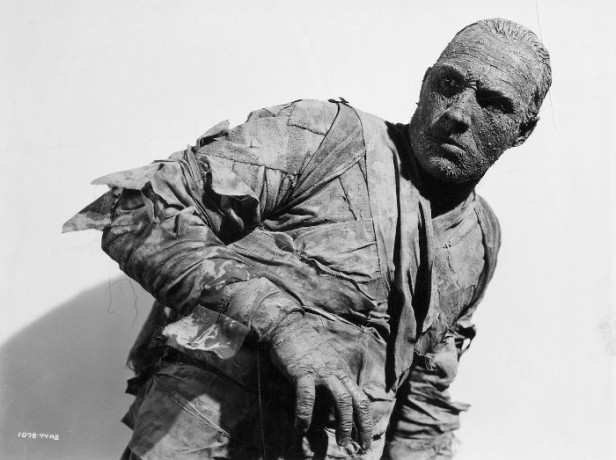Universal waited eight years to follow up The Mummy (1932) and when they did, in The Mummy’s Hand, they ignored all of the characters and events of Karl Freund’s original, though weren’t averse to recycling some of the footage from it for a flashback that’s still unrelated to the 1932 film. Christy Cabanne’s The Mummy’s Hand is a very different film to its predecessor, more of a traditional “monster movie” than the more thoughtful chiller Freund directed. It started a new franchise for Universal and in retrospect feels like the best of a pretty mediocre bunch.
Andoheb (George Zucco) is summoned to the Hill of the Seven Jackals in Egypt by the dying The High Priest of Karnak (Eduardo Ciannelli) who relates to him the story of Prince Kharis (Tom Tyler), who had been put to death three thousand years earlier after being caught trying to revive the recently deceased but much-loved Princess Ananka using the mystical powers of the tana leaf. Kharis has his tongue removed, is wrapped in bandages and is sentenced to be buried alive (conveniently enough, with a supply of tana leaves). He was subsequently revived by priests who charged him with protecting Ananka’s tomb, fluid from three tana leaves being administered at the full moon to keep him “alive” but in a state of suspended animation. Should anyone try to raid the tomb, a fluid made from nine leaves will restore his movement, but any more will make him uncontrollable. Back in Cairo, penniless American archaeologist Steve Banning (Dick Foran) and his sidekick Babe Jenson (Wallace Ford) follow a trail of clues, including a broken vase bought from a bazaar, to track down Ananka’s tomb. Despite warnings from Andoheb, the duo team up with the museum’s Dr Petrie (Charles Trowbridge) to enter the tomb, an expedition part-funded by American stage magician Solvani (Cecil Kelloway) and his daughter Marta (Penny Moran). Inevitably, Kharis is found and revived, Andoheb using him to stalk and kill the members of the expedition while he plots to inject himself and Marta, who he’s fallen in love with, with tana fluid, making them both immortal.

All the bits and bobs that we’ve come to expect these days from a screen mummy – the zombie-like demeanour, the bandages, the resurrection by tana leaves – were perfected here which is the film’s lasting legacy. Snappy, with little in the way of narrative flab, it rattles along at a decent enough pace, though some will find it annoying that the mummy isn’t revived until 42 of the film’s brief 66 minutes have gone by, 42 minutes spent in the company of characters more interested in cracking wise than digging up relics. But when he’s up and about, the film takes a darker turn and becomes very entertaining. Tyler, a former star of westerns, does a fine job as Kharis, using his one good hand (the other is withered and useless) to strangle all and sundry but who is eventually humbled by his addiction to tana leaf fluid, reduced at the climax to pathetically lapping up spilled juice as a fiery fate closes in on him.
Elsewhere, Dick Foran and Penny Moran (reunited the following year in Horror Island) make for bland leads and Ford is so irritating that you’ll soon be praying for the mummy to come along and put him out of our misery. But the show is stolen by the marvellous George Zucco, here making his debut in a Universal horror. He brings real menace and a dash of suaveness to the role of the film’s real villain, the mastermind who ends up controlling Kharis and using him as an instrument of his vengeance. He would grow tired of the villainous roles that he ended up being typecast in (“I really don’t think Hollywood did the best they might have done with George,” mused his widow years later to Gregory Mank for his book Hollywood’s Maddest Doctors) but he never brought anything but his very best to roles that he would increasingly come to dislike. He’s particularly good here, the film buzzing into life whenever he’s around.

The flashback features Boris Karloff if you look closely enough as it’s largely made up of footage from The Mummy‘s own flashback, detailing the tragic origins of Kharis, whose devotion to and love for Ananka would provide the connective tissue between this film and its three sequels (The Mummy’s Tomb (1942), The Mummy’s Ghost (1944), and The Mummy’s Curse (1944) – Abbott and Costello Meet the Mummy (1955) would go its own way). Universal made these follow-ups during the years when it was cranking out horror, mystery and thriller films at an extraordinary rate, as if on a production line, and they’d suffer because of it, though The Mummy’s Hand remains a fun romp that, it should go without saying really, isn’t a patch on The Mummy. But as an economical start to what is, in effect, a new franchise, it’s perfectly entertaining. In years to come the mythos established by The Mummy’s Hand and refined in the sequels would become the de facto back story for the mummy in most subsequent film, television, comic book and other appearances.